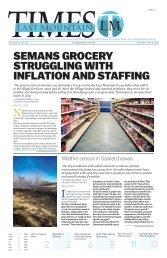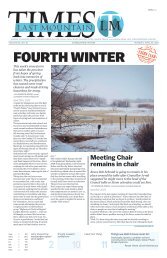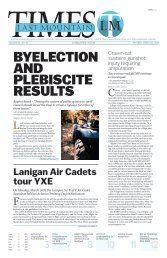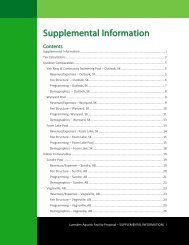LMT_Apr_17_2022_Vol_116_issue_17 v2
Create successful ePaper yourself
Turn your PDF publications into a flip-book with our unique Google optimized e-Paper software.
12 lmtimes.ca • Last Mountain Times • Monday, <strong>Apr</strong>il <strong>17</strong>, 2023<br />
CONTINUES FROM PAGE 1<br />
In the east, the water appears lower, becoming noticeably<br />
higher the further west you travel. Under<br />
the old Highway 6 bridge, water flows around and<br />
over what looks like an iceberg mass beneath. The<br />
ice is in various degrees of erosion.<br />
When I get to the Craven Dam, I luck out, and<br />
Water Security Agency staff are out making adjustments<br />
to the flow by raising the dam's gates slowly.<br />
When extreme flooding occurred in 2011, these<br />
gates were wide open. One of the people out today<br />
is Water Security Manager of Operations & Maintenance,<br />
Brad McClinton.<br />
The sound of the rushing water, as it passes<br />
through the gates, is surprisingly loud. It’s a sound<br />
one doesn’t normally equate to southern Saskatchewan<br />
life. If you close your eyes, you can almost<br />
imagine being at a waterfall on Vancouver Island.<br />
Instead, it’s run-of-the-mill springtime along the<br />
Qu’Appelle River at the Craven Dam. Beautiful in<br />
its own right. The dam regulates water flow along<br />
the river as it heads west towards the next dam at<br />
Echo Lake.<br />
McClinton said that it came in fast overnight, and<br />
they were there to open the gate “to naturalize the<br />
flow,” The flow rate was normal for the temperature<br />
changes that occurred. Sask Water Security Agency<br />
has a forecasting group monitoring the runoff and<br />
balancing the flows through the Qu’Appelle system.<br />
There will likely be several peaks. McClinton said<br />
the water was quite low the day before. “We saw<br />
this morning that it had come up substantially.<br />
So we got out here to open it up to let it naturally<br />
work.” They regularly return to the dam to gradually<br />
open the gates at an even pace so the flow erodes<br />
the ice instead of shattering it. He said it’s better<br />
when the ice breaks up into smaller pieces. McClinton<br />
tells me, “So it’s weakened deteriorated ice, so<br />
when it does break up, its smaller pieces. It basically<br />
breaks itself up as it touches another piece of ice,<br />
going smaller and smaller.”<br />
“We try to do everything we need to to make sure<br />
the flows are where we need them.”<br />
It will take a while for the water to migrate downstream<br />
to the next dam in the chain at Echo. The<br />
flow forecasters will monitor it for the right time<br />
when they can set the water at the recreational<br />
levels we all enjoy without causing flooding.<br />
We contacted Sask Water to see if there has been<br />
any new information and will update this story if<br />
more information becomes available.<br />
23044GE0
















